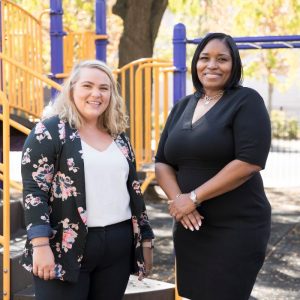
How Districts Can Expand Access to Literacy
12/01/2021

How OUSD is using curricula and professional learning to deliver on community demands for change
One clear lesson stands out from the global pandemic: too many students have long felt the impact of a society in need of change.
As classroom walls dissolved overnight, the realities of teaching and learning were laid bare. In Oakland, this dynamic ignited a vocal education movement to ensure that every student enjoys the right to read. The Oakland REACH and the Oakland NAACP quickly mobilized to call for all Oakland public schools to commit to research-based ways of teaching kids to read, including making sure teachers have the support they need.
laying the Groundwork
Oakland Unified School District (OUSD) is meeting this charge with a plan for students to “find joy in their academic experience while graduating with the skills to ensure they are caring, competent, fully-informed, critical thinkers who are prepared for college, career, and community success.”
The first step toward these goals was piloting multiple high-quality, literacy curricula with community input to support teachers to bring stronger lessons to life. Simultaneously, our organization, Leading Educators, worked with educators at three middle schools to demystify equitable literacy practice. We introduced a cyclical rhythm of professional learning that builds on teachers’ strengths and provides deep exploration of their materials. Last May, the Board of Education voted to adopt EL Education as a new foundation for literacy instruction after a rigorous vetting process.
Pilot participant Kate Sugarman shared about EL,
The conversations that teachers are having are focused more on what we want kids to learn, what they have to do, how they might struggle, and how teachers can support them.”
OUSD is making bold moves because they know curriculum is not enough. Teachers also need meaningful time to internalize the science of reading, collaborate, practice new strategies, and craft lessons together. When collaboration time, intentional professional learning, and strong materials are not in place, teachers’ jobs are harder and students miss out on the knowledge they need.
We know the potential of this work to seed lasting change, because we have seen it happen in our work with the District of Columbia Public Schools, where deep, curriculum-based teacher support in 116 schools has ignited new levels of student learning. In this piece, we unpack key practices we have used with OUSD educators to bring greater equity to literacy instruction.
Excellence Encompasses Rigor and Belonging
When students can read, they are prepared to access the world around them by building knowledge, thinking critically, speaking, writing, and responding. Knowing how students learn to read allows us as teachers to give students the tools to open doors—that’s why we teach. There is relative consensus in our sector about the research, so why is practice not more equitable?
Often, a chasm between intention and action for equitable teaching emerges as a false choice between rigor and cultural responsiveness. Rigorous teaching in literacy emphasizes using complex texts, evidence-based reading and writing, and building knowledge so that reading challenges students to think deeply and synthesize information from different kinds of sources (Boyles, 2018). Cultural responsiveness puts equal emphasis on development of self through academic-rich learning, affirmation of students’ identities and experiences, and critical engagement with the world; often diversity in text sets is an afterthought for curriculum developers, or diverse texts are not perceived as being complex enough (Lee, 2020).
Excellent teaching offers both. Students should get to spend most of their time on material that will prepare them for their next step while also experiencing affirmation and belonging.
Fortunately, we’re in the midst of a curriculum renaissance in which strong materials are more available than ever. But even when teachers have access to open education resources (OER), many are not designed to be culturally responsive on their own. Therein lies the most meaningful work for teachers—to be critical users of strong resources to reach every student. We believe teachers deserve a foundation of strong materials as well as robust opportunities to practice with intentionality, so they can focus more of their time and creativity on creating stand-out experiences.
Here are steps you can take when preparing for instruction, no matter your materials, to ensure students learn to read and feel seen.
-
Create Mirrors and Windows with Texts
Many literacy teachers want to teach from materials that reflect their students. So, Leading Educators’ twelve-week cycle of learning, based on the EL Education Language Arts Curriculum, breaks down culturally responsive literacy practices to build upon existing resources. First, teachers focus on a central idea of providing students “mirrors and windows” when selecting complex texts. Essentially, rigorous texts should mirror students’ identities and experiences while also offering windows into other worlds.
Rudine Sims Bishop writes,
When children cannot find themselves reflected in the books they read, or when the images they see are distorted, negative, or laughable, they learn a powerful lesson about how they are devalued in the society of which they are a part,” (1990). Matching positive representation with rigorous instruction encourages students to see their identities as strengths through which they can access the knowledge they need for their next step.
It’s important for teachers to build an understanding of the key ideas in complex texts so they can think through how to connect to student experiences. While OUSD teachers analyze texts for the key understandings they want students to grasp, our professional learning guides them to think about what their specific students will need. They plan and practice pedagogical moves with intentionality and anticipate unintended barriers before live instruction takes place.
To test the assumptions in their plans, teachers write exemplar responses to use as a reference for how it would look for students to demonstrate their learning at an appropriate level of rigor. Lastly, teachers learn how to synthesize all of this information by customizing and prioritizing the text dependent question sequences in their materials to scaffold students’ comprehension of complex texts while contributing to their expanding world view. Ideally, this becomes a continuous process that enables teachers of all experience levels and in any environment to reflect on what their students need to succeed. Ask yourself:
- How do I use my curriculum to help my students build world knowledge, see themselves represented, and maintain grade-level rigor?
- How do I think about the enhancements I use alongside my materials? Are they relevant to my students? Will they help students build knowledge?
- How do I analyze and respond to what I’m seeing in my students’ writing and assignments as I plan ahead?
-
Focus on Building Complex Language
A common problem of practice in literacy instruction is ensuring that students who are learning English have access to complex language. Fillmore and Fillmore’s research suggests “language dives” as a strong method for supporting language acquisition (2012). Language dives set up conversations about the meaning, purpose, and structure of a complex sentence (these are also referred to as “juicy sentences”). The point is to demystify how language works so all students have the tools to deconstruct, reconstruct, and practice using language structures.
Demystifying academic sentences supports students to understand the central ideas in a text while also learning how language works. Teachers might break a sentence into sections or chunks and ask students to think about why each component matters. Students can then rearrange these chunks into various configurations to explore how the meaning changes or doesn’t change. Teachers can then ask students to apply what they have learned about language to compose sentences of their own. Stepping into students’ shoes and going through the process during professional learning can offer insight into what all students will need to engage.
EL Education provides several free examples of how to use a language dive at www.eleducation.org.
-
Elevate Student Dialogue as Learning
Live conversation is a critical part of how learning happens. Teachers can use cues to encourage all students to speak up and support their ideas with evidence. Carefully crafted and sequenced cues create time for students to reflect and gather their thoughts before voicing their thinking. When teachers use conversation cues that build toward productive and balanced dialogue, they can more effectively link student participation to foundational, grade-appropriate concepts in what students are reading whether that be through sharing out loud, writing, or sketching.
Culturally responsive preparation for academic talk has to start from a belief that all students have something valuable to contribute. Sarah Michaels and Cathy O’Connor put it this way:
Teachers who orchestrate productive talk believe that even very young children can tackle challenging, rich, and ambiguous problems, and reason about them with evidence. They believe that if their students work hard at explaining their own ideas and think through the ideas of their classmates, they will become strong reasoners,” (Michaels, 2012).
Teachers should pay special attention to equity of voice. Often, students with a first language other than English or students who are labeled with a disability do not have or take the opportunity to speak. Conversation cues are just the first step to providing entry points for students. If you find disparities in who participates, you will want to be strategic in your planning to offer safe and welcoming opportunities to share ideas. Consider:
- Who is talking and when?
- What student-centered norms are at play in my classroom?
- What strategies can I try to balance participation (stop and jots, talking with a partner first, matching question types and response methods to student strengths and interests)?
-
Scaffold with Intentionality
Many teachers wonder how to balance grade level expectations and scaffolds for students who need more support. This definition from Bunch, Walqui, and Kibler is a helpful reminder: “We conceive of scaffolding not merely as ‘help’ provided to students to assist them in completing a momentary task but rather as supports specifically designed to induce students’ development and increase autonomy.”
Similar to the importance of setting an expectation that students are capable of productive academic talk, teachers should see students’ culture and experiences as powerful ways to increase their autonomy. Researcher Zaretta Hammond notes that cultural knowledge—an innate strength in every student—can be an entry point for students to deeply process new concepts and content (Ferlazzo, 2015). Culture should inform how we choose and use text sets that reinforce mastery of more challenging vocabulary and complex writing over time. There is strong evidence that covering a variety of relatable topics supports college- and career-ready growth (Achieve the Core, 2020).
Teachers who recognize the importance of using strong materials might worry about making adjustments. This is where it can be valuable to norm on what high and low levels of scaffolding could look like within the goals of the curriculum. To be clear, equitable adaptations, supplementation, and scaffolding are still a common growth area for curricular materials at large where significant innovation is needed.
Some strategies to balance rigor and support might include:
- using disaggregated formative data, exit tickets, and student work to to inform planning,
- reflecting on how you are using cultural knowledge and text sets to strengthen rigor,
- or identifying specific available resources for micro-level scaffolds.
Takeaway
At this critical moment, do not lose sight of instructional preparation. We must see them as whole and give them the opportunity to realize their own potential. Let us focus with clear eyes on building the fair and just future we all deserve through our practice.
Meet the Authors
Maggie Slye oversees national program implementation for Leading Educators as Deputy Chief of Networks. She also directly leads school system partnerships in Baltimore and Oakland. Notably, she led Leading Educators’ partnership with DC Public Schools on the groundbreaking LEAP program.
Amanda Silva has coached and led professional learning design for school systems in CA, DC, MD, and OK. She is a former middle school special education teacher and an ELA instructional coach.





